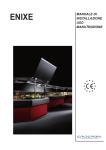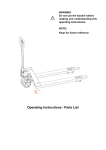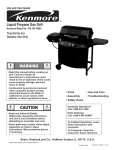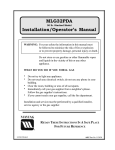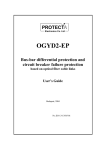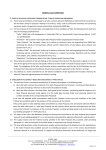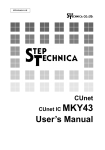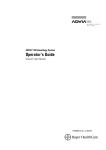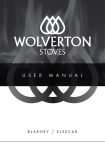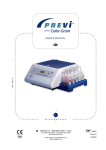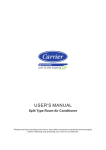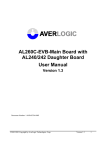Download FIRE PROTECTION RULES
Transcript
FIRE PROTECTION RULES Prepared by: Checked by: Approved by: László Márki Date: Date: Date: Date of coming into force: 01.08.2013 - Place of keeping the original (master) copy: Director’s Secretariat Copies given to competent persons - 2013 We reserve all rights in this document and the information contained therein. Reproduction, use or disclosure to third parties without express authority is strictly forbidden. 2 Fire Protection Rules Table of Contents I. Fire Protection Rules Responsibility for fire protection Duties of fire protection Appointed manager’s duties of fire protection Employees’ duties of fire protection Training of fire protection Behaviour in the case of fire II. Fire Protection Rules for Establishment and Use Classification into categories of fire hazard Fire protection rules General requirements Passages, exits, warehousing, storage Sewage system Electric equipment Fire hazardous activity Smoking Fire extinguishers Firing and heating equipment Rules related to periodical supervision Other rules Machinery, equipment Rooms of the Company III. Regulations Related to the Individual Rooms and Working Areas Office building Maintenance workshop Warehouse Social premises Locker room Outdoor vehicle store (parking lot) IV. Closing Provisions V. Supplements Appointment Declaration Specification of conditions for the performance of work involving fire hazard Classification into categories of fire hazardousness Duties in the case of fire Time schedule of supervisions Register of fire extinguishers 3 Fire Protection Rules In conformity with the laws on fire protection in force: Paragraph (1) of Section 19 of Act XXXI of 1996 as amended, Act XLII of 2003 /GET/, Government Decree No. 259/2011.(XII.7.), Government Decree No. 111/2003.(VII.29.), Decree No. 33/1999. (IX.24.) and 10/2011.(III.28.) BM as amended by Decree No. 30/1996.(XII. 6.) BM, Decree No. 32/2002.(XII.12.) BM, Decree No. 45/2011.(X.29.), On the basis of National Fire Safety Regulation – furthermore NFSR modified by Decree No. 55/2012.(X.29.) BM, putting into effect by Decree No. 28/2011.(IX.6.) Decree No. 53/2005.(XI.10.) BM, I hereby issue the ad hoc detailed fire protection prescriptions for the area and premises of PACONT Kft. (1138 Budapest, Váci út 152156.) – hereinafter: company. The aim of the Fire Protection Rules is to lay down uniformly, for the whole Company, the fire protection duties of the managers and workers – employees – as well as the rules of the fire protection procedures and the general requirements related to work performance and use. They determine joint liability as well as the distribution and scope of liability in individual cases. Budapest, 1st August 2013 ......................................... Managing Director 4 I. Duties of Fire Protection, Training, Behaviour in the Case of Fire 5 1. The managing director is responsible for the fire protection of the Company. A.) Subject to this responsibility any other employee working at the Company and having fire protection qualifications specified by the law or any fire protection entrepreneur may be appointed in writing to carry out the duty of fire protection. B.) The material and objective conditions of fire protection are provided by the owner at the costs of the Company. 1.1. Based on the relevant statutory provisions I appoint László Márki as fire protection entrepreneur to perform the uniform direction of the Company’s fire protection. In the scope of this authorization and activity he is obliged to: - organize and supervise the Company’s fire protection as specified in the Fire Protection Rules, - perform the fire protection training of the employees or have it performed, - report to the regionally competent municipal fire headquarters on any change affecting the situation of fire protection and on the commencement of the activity at least 15 days in advance, - take part in the firer protection control and inspection (to have himself represented by an appointed person authorized to take measures in the case of his absence) and arrange for the elimination of the detected shortcomings, - control the fire protection activity and the observance of the fire protection prescriptions regularly, - see after that the fire protection equipment and devices are ensured, - monitor the completion of fire protection inspections in accordance with this instruction, - determine the necessary conditions in writing for ad hoc fire hazardous works. 6 2. Appointed manager’s duties of fire protection For the purpose of application of the rules each employee of the Company, who fulfils an independent, specified scope of duties in any field or directs others in his scope of duties, is deemed as a manager. The manager is obliged to fulfil his duty of fire protection according to the provisions of the laws. The manager is the responsible director of the fire protection activity in his scope of operation. Accordingly, he determines: - the scopes of duties and liability in connection with the execution of fire protection prescriptions as well as the order of fire protection activity and behaviour, - the requirements related to the fire protection activity and its performance, - takes measures and initiates measures to eliminate shortcomings and irregularities of fire protection detected on the basis of control and other experiences, as well as to execute the necessary procedures in justified cases, - helps and ensures the control work of authorities and persons authorized to control, - sees after that the fire protection prescriptions laid down in laws, standards and official regulations are fulfilled during the planning, construction and procurement of new equipment, devices and machinery, as well as the modernization and extension of existing ones. 3. Workers’ and employees’ duties of fire protection Any person performing any activity by any virtue in the territory of the Company is deemed as a worker or employee. The worker or employee: - is obliged to take care of his own and his colleagues’ safety and health during work performance, 7 - is obliged to acquire the knowledge of fire protection necessary for his job and to use and observe it fully during his work, - has to know the possibilities and way of fire alarm in his working area, - has to know the escape routes and emergency exits, - has to know the location of the fire extinguishers and the way of their use, - has to check his working area after finishing work and see after the elimination of any possible causes of fire, - has to attend the training of fire protection, - is obliged to act according to the behaviour specified for the case of fire when any fire or extraordinary event occurs. The worker has to be prohibited from work if: - he has not attended training of fire protection, - he performs his work in an undisciplined manner and thus endangers fire safety as well as his colleagues’ health and life. Prescriptions applicable to workers of outside companies, contractors and subcontractors performing subcontractors’, maintenance, etc. work in the territory of the Company: - Upon the handing over of the working site the conditions of safe work performance have to be ensured for outside workers. 8 - The prescriptions and measures related to the fire protection of the working site have to be put down in detail in an agreement or contract. - In each case the local manager of the firm or enterprise preparing the site for building has to be specified as the person responsible for the duties of fire protection and he has to be informed of all these properly and in sufficient detail. He has to be acquainted with the Fire Protection Rules to the required extent. 4. Training of fire protection Within the Company training is - basic training - repeated training When being set to work and subsequently at least once a year the workers have to be given training of fire protection corresponding to their jobs. The training has to cover: - the fire hazardousness of the workplace and the working process, - the preventive regulations of fire protection and prescriptions of use, - the use of the installed fire-fighting devices, fire extinguishers and equipment, - the obligation of reporting on fire, - the possibility and way of fire alarm, - the behaviour in the case of fire, - the consequences of violating fire protection rules. Records have to be kept of the training. 9 The fact of the completion of training has to be signed by the workers. (Journal of Fire Protection Training) 4.3. Extraordinary training has to be provided prior to the introduction and use of a new fire hazardous and explosive technology, machine, material, etc. for the people working there irrespective of the fact whether it has been taught earlier, as well as after the occurrence of fire. 5. Behaviour in the case of fire If fire breaks out the workers and guests /buyers/ have to be alarmed and from nearest telephone set it has to be reported immediately – without delay – to the fire brigade (No. 105) and to the responsible workplace manager. Any fire extinguished by the workers must also be reported immediately to the fire brigade. When reporting on fire the following facts have to be mentioned: - the location of fire (exact address), - whether human life is endangered, - what kind of a material is burning and what the fire endangers (where it can extend to), - the name of the reporting person and the phone number from which fire is reported. Simultaneously with reporting on the fire attempts have to be made at rescuing people and objects as well as extinguishing the fire by means of the available fire extinguishers. Next to the telephone sets with city exchange line the phone number of the fire brigade (other emergency numbers as well) has to be indicated. 10 II. Fire Protection Rules for Establishment and Use 11 1. Classification into categories of fire hazard For the purpose of determining and applying fire protection regulations the materials, activities, premises, outdoor areas and the establishment have to be classified into categories of fire hazard in conformity with Paragraph 560-562 Chapter XXXII of the National Fire Protection Rules – hereinafter OTSZ – entered into force by Decree No. 28/2011.(IX.6.) ÖTM. The classification into categories of fire hazard is included in the supplement. Five categories of fire hazard are distinguished: “A” increasingly inflammable and explosive “B” inflammable and explosive “C” inflammable “D” moderately inflammable “E” non-flammable 2. Description of the Fire Protection Rules The workers have to be made acquainted with the prescriptions of the fire protection rules in the form of training. The competent employee (manager) is responsible for knowing, observing and causing to be observed of the of the fire protection rules as well as for controlling their contents. 3. General requirements The building, machine or equipment may be used only in possession of a permit of putting into use and operation, in conformity with the purpose specified in such permit, keeping the prescriptions of fire protection. In the premises only the materials and devices necessary for the continuous activity performed there may be stored. Usually their quantity may not exceed the daily material need. 12 The wastes produced during the activity have to be removed continuously, if possible, but after the end of the working hours at the latest. During each activity for which inflammable and explosive combustible fluids or materials (solvents, cleaning agents, washing agents, adhesives, etc.) are used – even if only occasionally – the activity may be started or continued only if the proper warning(s) – prohibition of smoking and the use of naked flames, etc. – have been seen after preliminarily and efficient ventilation has been ensured. During and after work performance the observance of the fire protection instructions for use has to be controlled. Any irregularities have to be eliminated. At the entrances to the rooms and outdoor storage areas the signs of prohibition and warning related to such places have to be placed in an easily visible manner. The doors of the rooms must not be locked as long as there are people in them. The opening and closing structures of public utilities, electric main switches, fire extinguishers, fire-fighting equipment and devices have to be marked in an easily visible manner. For the periods of standstill the keys to the locked rooms have to be placed in such a way that they may be available in the case of damage. 4. Passages, exits, emergency exits, warehousing, storage The entrances, exits and passages of the establishment and premises have to be kept unblocked all the time. The inner passages of the premises have to be constructed in such a way that in the case of fire or any other hazard the people staying there may get outside or to any safe place without difficulty. - In premises not wider than 15 metres a 1.2 metres wide passage and in premises not wider than 10 metres a 1 metre wide passage. 13 In rooms below ground level and in the attic the storage, processing and packaging of materials falling into fire hazard categories “A” and “B” is FORBIDDEN – even temporarily! In rooms below ground level – basement, cellar, etc. – the storage, use and/or placement of any type and sort of gas bottles with any contents is FORBIDDEN! Gateways, entrances, vehicle driveways and emergency exits have to be kept unblocked in full width all the time. Such areas must not be blocked or narrowed down even temporarily. The doors of the emergency exits have to be constructed in such a way that they may open outwards. The locking structure has to be such that it ensures escape. The switches of electric equipment, the opening and closing structures of public utilities (gas, steam, water), fire protection equipment, appliances and devices have to placed in an easily accessible manner all the time. Blocking them is strictly forbidden! 5. Sewage system Inflammable gases, steams and sewages containing inflammable fluids must not be led directly into the sewer. It is forbidden to pour any inflammable fluids, acids and alkalis into the gutter or sewer. 6. Electric equipment During the installation and operation of electric equipment the relevant standards and regulations as well as the instructions specified for the individual fire hazard categories have to be kept. Electric heating appliances (cooking plates, coffee makers, etc.) may only be operated at the designated places, with fireproof, inflammable and heat-insulated pads, and such 14 appliances may be connected only to wall-sockets supplied with control lamps and switches. In the area of the Company only standard electric lighting corresponding with the fire hazard category may be used. Between the lighting and electric equipment as well as any inflammable material such a distance has to be kept that it may not mean a danger of ignition to the inflammable materials. Therefore, a minimum fire distance of 0.6 metre has to be kept between the lighting and electric equipment. Under the switchboards of electric equipment (fuse, distributor, boxes, etc.) inflammable materials may not be stored. The purpose of electric switches, fuses and distributors placed in groups as well as the switched on and off positions of such switches have to be indicated. The electric equipment, mains and lightning protection fittings and equipment have to be supervised in conformity with the relevant standard. In the territory of the Company only standard electric machinery, equipment and appliances owned by the Company and supervised in accordance with the prescriptions may be used. 7. Fire hazardous activity It is forbidden to perform any fire-hazardous activity (welding, oxygen cutting, sticking, etc.) in places where it may cause fire or explosion until the danger of fire or explosion is eliminated. Permanent fire-hazardous activities may be performed only at (designated) places constructed for such purpose and meeting the fire protection requirements. 15 Fire hazardous activities may be performed only by persons trained in the fire protection rules and having a valid special examination. The worker concerned has to keep the certificate of special examination with himself and present it upon request to the person authorized to control. Occasional fire hazardous activities may be performed only on the basis of a preliminary written specification of the conditions. The specified conditions are issued by the Company’s competent person. (See: supplement) 7.5. In the case of a fire hazardous activity to be performed by an outside company (contractor, etc.) the conditions of the activity have to be agreed upon with the Company’s managing director or authorized representative. The written specification of the conditions is issued by the Company’s managing director. When licensing or performing any fire hazardous activity special care has to be devoted to the removal of inflammable fluids and materials all the time. For any occasional fire hazardous activity performed in a fire hazardous environment supervision has to be ensured in each case. For the fire hazardous activity the licensing party is obliged to provide fire-fighting equipment and fire extinguishers suitable for extinguishing the fire occurring there. 7.9. After the completion of the fire hazardous activity the person performing the work is obliged to check the site and its vicinity with respect to fire protection and eliminate any circumstances that may cause fire. The completion of the work has to be reported to the customer and the work performed as well as the working site has to be handed over. Flame welding and arc welding – hard soldering – may be carried out only by persons having passed the special examination and possessing certificates of special examination. During the flame welding activity the prescriptions of the standard MSZ 6292 and the safety rules of welding have to be kept. 16 During electric arc welding the prescriptions of the standard MSZ 6299 and those of safety rules of welding (OTSZ) have to be kept. Any fire hazardous activity not subject to a special examination may only be performed by persons trained for the rules and prescriptions of fire protection. 8. Smoking Smoking is forbidden in rooms falling within fire hazard categories “A”, “B” and “C” as well as in all such places where smoking can cause fire. At such places the prohibition signs specified in the standard have to be placed. In any other respects order nr. XLII of 1999 provides which is in the protection of non-smokers. It is forbidden to empty matches, cigarette butts and burnt tobacco products into wastepaper baskets or dustbins serving for the storage of other inflammable materials, even in put out condition! Smoking is permitted only at the designated places. I give separate instructions for smoking in Chapter III of these Rules. 9. Fire extinguishers At the establishments fire extinguisher(s) meeting the laws and standards have to be placed and kept ready. I give concrete instructions for this in Chapter III of these Rules. Workers have to be trained to operate the fire extinguishers and fire-fighting devices and they have to practice their use. The periodical checking of the hand fire extinguishers has to be performed. The hand fire extinguishers may only be placed in the standard manner. The places of the fire extinguishers have to be supplied with "Fire Extinguisher" 17 marking, after-lighting boards and registration (serial) numbers and also with afterlighting user manual (pictograms). 10. Firing and heating equipment 10.1. In buildings and premises only such heating systems may be established and used which do not cause fire or explosion if properly operated. 10.2. Only firing and heating equipment of permitted types and excellent technical condition may be used. 10.3. Between the firing and heating equipment as well as any inflammable material in their vicinity such a distance has to be kept or such an insulation has to be applied which ensures that the temperature measured on the surface of the inflammable material may not exceed 60 oC even during operation with the highest heat load. 11. Rules related to periodical supervision The supervision of electric equipment with respect to fire protection takes place in accordance with the provisions of Chapters XXV §390 of the National Fire Protection Rules in every three years in premises and outdoor areas falling within fire hazard categories “A” and “B”, in every six years in premises and outdoor areas falling within fire hazard category “C”, and in every nine years in premises and outdoor areas falling within fire hazard categories “D” and “E”. In the case of establishments lightning protection has to meet the prescriptions specified in standard MSZ 274/2-3. Periodical supervision is prescribed by standard MSZ 274/4 depending on the classification into categories of fire hazard, simultaneously with the supervision of electric equipment. Supervision of gas-operated equipment 18 Based on the Gas and Oil Industry Technical Safety Rules (GOMBSZ), pieces of gasoperated equipment have to be inspected yearly and records have to be kept of such inspection. Checking of fire extinguishers and fire equipment The fire extinguishers and fire equipment have to be checked and maintained in accordance with the valid standards. The operational safety of hand fire extinguishers has to be checked in every half year (MSZ 1040 series) or yearly (MSZ-EN 3 series) by a person with a special examination or by a specialized company. A hand fire extinguisher is regarded as a pressurized vessel therefore it has to be submitted to a pressure test in every 5 years. After the lapse of 20 years the appliance has to be sorted out. (Safety Rules of Pressurized Vessels) Only standard and regularly checked and maintained appliances may be kept ready in the area of the establishment. In the area of the establishment only appliances suitable for extinguishing the fire occurring there may be used. The chimneys in the area of the establishment have to be cleaned if necessary and supervised yearly. 12. Other regulations In the case standstill in the establishment the current has to be cut off and other public utilities suitable for causing fire (gas, etc.) have to be switched off. After the cut-off the operation of the following equipment is permitted, that is, they need not be cut-off: - refrigerators, - electronic cash registers, computer centres, property insurance and fire alarm equipment, - shop-window and sign lighting. 19 During standstill other equipment – apart from central and district heating – may not operate! 13. Machinery, equipment Only such machinery and equipment may be used which satisfy the fire protection and other safety regulations related to the place of use during their operation and do not cause fire or explosion if properly operated. Technological instructions and instructions for use specified by the manufacturer have to be placed next to fire hazardous machinery and equipment. In the case of rotating and rubbing machine parts warming up, which means a fire hazard, has to be prevented. No machine may operate without supervision! The cleaning of machinery and equipment has to be seen after continuously. Any broken down machinery or equipment has to be stopped! 14. Social premises, store, office, etc. 14.1. In the case of premises belonging to the Company I give concrete instructions in Chapter III. 20 III. Regulations Related to the Individual Rooms and Working Areas 21 1. Office building The building falls within the fire hazard category “D”, that is “Moderately fire hazardous”. 1. The rooms may be used only for the permitted purposes. 2. The pieces of furniture, fittings and equipment of the rooms have to be placed in such a way that in the case of danger people in the rooms may get to a safe place, as well as the electric switches, the opening and closing structures of public utilities and the fire extinguishers may be accessed without difficulty. 3. It is forbidden to narrow down the passages, entrances and exits or to block the electric switches, opening and closing structures of electric switches or fire extinguishers (even temporarily)! 4. Smoking and the use of naked flames is not permitted. The prohibition has to be indicated by a standard sign or pictogram. 5. Any occasional fire hazardous activity (welding, oxygen- and fast cutting, etc.) may be carried out only after the specification of the conditions in writing! 6. It is forbidden to take or store in the rooms any materials falling within fire hazard categories “A” and “B” or materials susceptible to self-ignition! 7. The produced wastes have to be removed from the rooms continuously but at least at the end of the working hours. 8. Only standard electric lighting may be used in the rooms. 9. The employee (manager) leaving the room last is obliged to carry out examination regarding fire protection and to cut off current. 22 10. Next to the telephone sets with city exchange line the phone number of the fire brigade (105) has to be indicated. 11. The fire protection of the room has to be ensured by a fire extinguisher. 1. Office premises The office premises fall within the fire hazard category “D”, that is “moderately fire hazardous”. 1.1. If smoking is permitted, with the following conditions: - a sufficient number of ashtrays made of non-flammable materials has to be ensured for each room - burning tobacco products may be placed only in the ashtrays but they must not be left unattended - it is forbidden to empty burning tobacco products or the contents of the ashtrays into waste-paper baskets or dustbins serving for the collection of other inflammable materials! - the contents of the ashtrays and burnt tobacco products may only be emptied into vessels made of non-flammable materials and not containing any other inflammable materials - any fire hazardous activity (welding, etc.) may only be carried out in the office premises on the basis of the preliminary written specification of the conditions. 1.2. The pieces of furniture of the office premises, the materials and fittings necessary for operation may be placed only in such a way that – if necessary – they may enable escaping as well as easy access to the electric switches, the opening and closing structures of public utilities and the fire extinguishers. 1.3. It is forbidden to take or store in the office premises any inflammable or explosive fluids as well as materials susceptible to self-ignition! 1.4. In the office premises only standardized equipment in perfect condition may be used. - electric heating and heat-producing appliances (coffee maker, cooking plate, heat radiator, etc.) may be operated as follows: - they may be operated only connected to a wall-socket supplied with a control lamp and switch as well as placed on a stand made of non-flammable materials 23 - it is forbidden to keep any inflammable materials in a 30 cm vicinity of the appliances! - it is forbidden to keep the appliance unattended when it is switched on! - only technicians may repair the electric equipment - after the working hours the electric equipment of the office premises have to be cut off! The person leaving the premises last is obliged to cut off the appliances and equipment and to withdraw them from use. 1.5. The fire protection of the office premises has to be ensured by a fire extinguisher. - The workers have to know the location and use of the fire extinguisher! - It is forbidden to remove the fire extinguisher from its location and use it for any purpose other than its intended purpose! 2. Warehouse/s/ The premises fall within fire hazard category “C”, that is “fire hazardous”. 1. The premises may only be used for the permitted purpose. 2. In the area of the warehouse a minimum 1 metre wide passage and the full width of the entrance and exit have to be ensured. 3. The material stock has to be placed in such a way that easy access to the electric switches, the opening and closing structures of public utilities and the fire extinguishers as well as the possibility of getting to a safe place in the case of danger may be ensured. 4. Smoking and the use of naked flames is forbidden in the premises! The prohibition has to be indicated with a standard sign. 5. Any occasional fire hazardous activity may be performed only on the basis of the preliminary written specification of the conditions. 24 6. In the premises materials falling within fire hazard categories “A” and “B” and those susceptible to self-ignition may only be stored in standard, explosion-proof cupboards in the quantity specified in the standard. 7. Only standard electric lighting supplied with lampshades may be applied. 8. In the premises materials may be placed only in such a way that they may be at a safe distance (60 cm) not meaning a danger of ignition from any lighting and heat-producing equipment. 9. The cleaning of the premises has to be arranged for if necessary and the produced wastes have to be removed every day. 10. The employee (manager) leaving the premises last is obliged to examine the premises regarding fire protection to cut off the current. 11. The fire protection of the premises has to be ensured by a fire extinguisher. 3. Social premises (toilets, shower rooms, lavatories and their entrances), passages The listed premises fall within the fire hazard category “E”, that is “non-flammable”. 1. If smoking is permitted in the listed premises, under the following conditions: a sufficient number of ashtrays made of non-flammable materials have to be placed in the premises. It is forbidden to leave any burning tobacco products unattended, and the ashtrays have to be emptied daily. Any fire hazardous activity may be performed only with a permit. 2. In the premises listed above only pieces of furniture and fittings corresponding with their nature may be used. It is forbidden to store any other materials or narrow down or block the passages! It is forbidden to store any inflammable materials even temporarily! 3. Easy access to the electric switches as well as the opening and closing structures of public utilities located in the premises has to be ensured! 25 4. The doors of the premises may not be blocked or locked while there are people in the premises even temporarily. 5. In the case of danger getting to a safe place from the premises has to be ensured. 4. Maintenance workshop The premises fall within fire hazard category “D”, that is “moderately inflammable”. 1. The premises may be used only for the permitted purpose. 2. Smoking is not permitted - in the premises fire hazardous activities (welding, etc.) may be performed only on the basis of advance written specification of the conditions. 3. The pieces of furniture of the premises, the materials and fittings necessary for operation may be placed only in such a way that – if necessary – they may enable escaping as well as easy access to the electric switches, the opening and closing structures of public utilities and the fire extinguishers. 4. It is forbidden to store any inflammable and/or explosive fluids in the premises as well as to take or store there any materials susceptible to self-ignition! 5. The used rags covered with oil, thinner and paint have to be stored separately from each other in containers made of non-flammable materials and covered with non-flammable lids. 6. Only standardized electric equipment of perfect condition may be used in the premises. - electric heating and heat producing appliances (cooking plate, heat radiator, etc.) may be operated as follows: - only connected to a wall-socket supplied with a control lamp and switch, and placed on a stand or pad made of non-flammable materials, - it is forbidden to store inflammable materials in 30 cm vicinity of the appliances 26 - the electric equipment may only be repaired by technicians, - after the working hours the electric equipment of the premises have to be cut off! The person leaving the premises last is obliged to cut off and withdraw the appliances and equipment from use as well as to carry out examination of fire protection. 7. The fire protection of the premises has to be ensured by 2 fire extinguishers. - the workers have to know the locations and use of the fire extinguishers! - it is forbidden to remove the fire extinguishers from their locations and use them for purposes other than their intended purpose! 5. Locker room The premises fall within fire hazard category “C”, that is “inflammable”. 1. The premises may be used only for the permitted purpose. 2. Smoking and the use of naked flames is forbidden. The prohibition has to be indicated by a standard sign or pictogram. 3. Any fire hazardous activity may be carried out only after the specification of the conditions in writing. 4. Clothes covered with oil may be stored only in metal lockers. 5. Only standard lighting supplied with lamp shades may be used in the premises. 6. It is forbidden to take or store in the premises any materials falling within fire hazard categories “A” and “B” or materials susceptible to self-ignition! 7. The pieces of furniture and fittings of the premises have to be placed in such a way that in the case of danger the possibility of getting to a safe place and easy access to the opening and closing structures of public utilities, the electric switches and the fire extinguishers may be ensured. 27 8. The door of the premises must not be locked or blocked even temporarily when there is any person inside! 9. The person leaving the premises last is obliged to carry out examination regarding fire protection and to cut the current off! 10. For the fire protection of the premises a fire extinguisher has to be kept ready. 28 IV. Closing Provisions 29 The execution of the contents of the Rules is binding upon all workers of the Company. Violation of the prescriptions or their improper execution and fire arising from it can result in - the termination of the employment, - proceedings of contravention, or in more serious cases - criminal procedure. The Fire Protection Rules will come into force from the day of their announcement. Budapest, 1st August 2013 .............................................................. Managing Director 30 V. Supplements 31 DECLARATION I THE UNDERSIGNED DECLARE THAT I HAVE READ THE ISSUED FIRE PROTECTION RULES AND I HAVE UNDERSTOOD AND ACQUIRED THEIR CONTENTS BEING AWARE OF MY DISCIPLINARY LIABILITY. I CERTIFY THE AUTHENTICITY OF MY DECLARATION WITH MY SIGNATURE. Name: ……………………………………. Signature: …………………………………. Name: ……………………………………. Signature: …………………………………. Name: ……………………………………. Signature: …………………………………. Name: ……………………………………. Signature: …………………………………. Name: ……………………………………. Signature: …………………………………. Name: ……………………………………. Signature: …………………………………. Name: ……………………………………. Signature: …………………………………. Name: ……………………………………. Signature: …………………………………. Name: ……………………………………. Signature: …………………………………. Name: ……………………………………. Signature: …………………………………. Name: ……………………………………. Signature: …………………………………. Name: ……………………………………. Signature: …………………………………. Name: ……………………………………. Signature: …………………………………. Name: ……………………………………. Signature: …………………………………. Name: ……………………………………. Signature: …………………………………. Name: ……………………………………. Signature: …………………………………. 32 SPECIFICATION OF CONDITIONS for work performance involving fire hazard Based on the on-site survey held on ………………..…........... (date) I give permission to the worker(s), number of special examination: ……………………………. to perform work involving fire hazard in the area of ……………………………………………………… in premises and outdoors ……..……..……………………………………………………………………………. for a period of …………………………………….. days, fully keeping the fire protection rules listed below. 1./ Welding and oxygen cutting may be carried out only by a person with proper qualifications, trained for the fire protection rules and having a valid special examination in fire protection, using examined equipment and tools in perfect condition. 2./ It is forbidden to perform any fire hazardous activity at any place where it may cause fire or explosion until the danger of fire or explosion has been eliminated. 3./ Further regulations (the required preventive duties of fire protection have to be listed in detail): ………………………………………………………………………………… …………………………………………………………………………………………… ……………………………………………………………………………………………… ……………………………………………………………………………………………… ……………………………………………………………………………………………… 4./ At the workplace ………… pcs of fire extinguishers, …………… m3 of sand, ….. pcs of spreading shovels, …………… litres of water, and a …………… m2 large wet canvas cover have to be kept ready. 5./ For the whole period of work performance involving fire hazard for the examination of the working area and for inspection I designate: ……………………………………… ………………………………………………………………………………………………. 33 ……………………………………………………………………………………………… ……………………………………………………………………………………………… ………………………………………………………………………………………………. 6./ After the completion of the fire hazardous activity the person performing the work is obliged to examine the site and its vicinity regarding fire protection and eliminate any circumstances that may cause fire. The completion of the work has to be reported to the person ordering the work. I have acknowledged the prescriptions specified in the conditions and assume legal liability for their continuous observance. ………………………, ………..…………………..…… . ………………………………….. Signature of work performer 34 Fire classification of PACONT KFT “D” i.e. “moderately flammable”, 35 DECLARATION I THE UNDERSIGNED DECLARE THAT I HAVE READ THE ISSUED FIRE PROTECTION RULES AND I HAVE UNDERSTOOD AND ACQUIRED THEIR CONTENTS BEING AWARE OF MY DISCIPLINARY LIABILITY. I CERTIFY THE AUTHENTICITY OF MY DECLARATION WITH MY SIGNATURE. Name: ……………………………………. Signature: …………………………………. Name: ……………………………………. Signature: …………………………………. Name: ……………………………………. Signature: …………………………………. Name: ……………………………………. Signature: …………………………………. Name: ……………………………………. Signature: …………………………………. Name: ……………………………………. Signature: …………………………………. Name: ……………………………………. Signature: …………………………………. Name: ……………………………………. Signature: …………………………………. Name: ……………………………………. Signature: …………………………………. Name: ……………………………………. Signature: …………………………………. Name: ……………………………………. Signature: …………………………………. Name: ……………………………………. Signature: …………………………………. Name: ……………………………………. Signature: …………………………………. Name: ……………………………………. Signature: …………………………………. Name: ……………………………………. Signature: …………………………………. Name: ……………………………………. Signature: …………………………………. 36 SPECIFICATION OF CONDITIONS for work performance involving fire hazard Based on the on-site survey held on ………………..…........... (date) I give permission to the worker(s), number of special examination: ……………………………. to perform work involving fire hazard in the area of ……………………………………………………… in premises and outdoors ……..……..……………………………………………………………………………. for a period of …………………………………….. days, fully keeping the fire protection rules listed below. 1./ Welding and oxygen cutting may be carried out only by a person with proper qualifications, trained for the fire protection rules and having a valid special examination in fire protection, using examined equipment and tools in perfect condition. 2./ It is forbidden to perform any fire hazardous activity at any place where it may cause fire or explosion until the danger of fire or explosion has been eliminated. 3./ Further regulations (the required preventive duties of fire protection have to be listed in detail): ………………………………………………………………………………… …………………………………………………………………………………………… ……………………………………………………………………………………………… ……………………………………………………………………………………………… ……………………………………………………………………………………………… 4./ At the workplace ………… pcs of fire extinguishers, …………… m3 of sand, ….. pcs of spreading shovels, …………… litres of water, and a …………… m2 large wet canvas cover have to be kept ready. 5./ For the whole period of work performance involving fire hazard for the examination of the working area and for inspection I designate: ……………………………………… ………………………………………………………………………………………………. 37 ……………………………………………………………………………………………… ……………………………………………………………………………………………… ………………………………………………………………………………………………. 6./ After the completion of the fire hazardous activity the person performing the work is obliged to examine the site and its vicinity regarding fire protection and eliminate any circumstances that may cause fire. The completion of the work has to be reported to the person ordering the work. I have acknowledged the prescriptions specified in the conditions and assume legal liability for their continuous observance. ………………………, ………..…………………..…… . ………………………………….. Signature of work performer 38 FIRE ALARM PLAN The effectiveness and application of the “Fire Alarm Plan”: the effect of the regulation covers the whole territory of the establishment, PACONT Kft (Budapest, XIII. Váci út 152.-156.), its outdoor areas, leased, used, etc. premises, the people staying there and all employees of the establishment. It is applicable • during the occurred cases of fire • in the case of damage through disaster • in the case of any other event if justified by emergency • during fire alarm practice Fire alarm • the person detecting the fire or the person requested by him is obliged to carry out ”FIRE ALARM” to the fire brigade immediately, • the fire alarm has to include • • • • • the exact location and address of the fire, what is burning and what is endangered, whether human life is endangered, the alarming person’s name and phone number the way of fire alarm • fire alarm on the phone from the reception • on the phone with city exchange line from their offices or using a street phone, dialling the emergency numbers 105 or 112, • through a messenger or courier if the phone cannot be used for some reason. • through the reception service • using the house telephone system • by personal communication. 39 WARNING! The information has to conform to reality. The event must not be exaggerated or underestimated. Each fire that has occurred, even the one that has gone out without human intervention, has to be reported to the professional municipal fire brigade. The scene of the damage has to be left in unchanged condition until the inspection of the fire is completed and, if necessary, its watching has to be ensured, e.g. the place must not be put in order, etc. -. ALARMING After – or if possible, simultaneously with – the fire alarm the people staying in the building have to be alarmed to perform their duties of fire protection /life-saving, evacuation, fire-fighting, etc./. For alarming the house telephone system and personal alarming has to be used. The execution of alarming: - During the working hours • the person fulfilling security service is obliged to provide quick and precise information on the event that has occurred and to take measures to execute the necessary duties such as rescue, escape, fire-fighting, etc. ATTENTION, FIRE ALARM! • • the employees have to leave the building or endangered place in an orderly way, he calms the people staying in the building several times and takes measures at quick and panic-free evacuation, etc. - During holidays • the person fulfilling security service is obliged to take proper measures, e.g. to carry out the FIRE ALARM, to alarm the people in the establishment, • he takes measures at solving the urgent matters – e.g. rescuing, fire-fighting, etc. • - executes the duties specified for NOTIFICATION, etc. 40 RESCUE • in each case of damage the most important duty is to rescue people in danger. If there is the slightest suspicion of this, then life-saving has to be started immediately, • people in danger have to be rescued even at the cost of risking the security of the rescuing forces and teams, • the rescued people have to be given first aid and medical care has to be arranged for. The phone number of the AMBULANCE is 104 on a city exchange line, • all other duties such as the saving of objects, fire-fighting, etc. may be performed only with the forces not required for life saving. EVACUATION, ESCAPE • in the case of fire no people, who do not have any duties in rescuing, fire fighting, etc., may stay in the establishment. Those, who have no such duties, have to leave the establishment, • the leaving people have to get to safe areas within 6 minutes at the most. I designate the street areas and the yard as safe places, • as long as there are people in the establishment, the exits and passages leading to the outdoor areas have to be kept unblocked and open, • for evacuation and escape each exit leading to the outdoor areas has to be taken into account. Their utility, standard marking, beacon lighting, etc. have to be ensured. FIRE FIGHTING The conditions of fire fighting: • fire alarming to the professional municipal fire brigade has to be executed immediately, • after the alarm the special teams having been trained properly will start their activity immediately on the basis of the instructions received 41 The aim of detection is to accelerate efficient and safe intervention using the experiences gained about the event and the condition of the place of damage, taking into account the following: • • • • • • • • where is the fire, what is the direction of its spreading, what is burning, is human life in danger? is there any explosive materials in the vicinity of the fire? what is endangered due to radiating heat, etc. where is the seat of the fire and how can it be approached? by what can the fire be extinguished and from where can the extinguishing agent be ensured? how can the available force be deployed? what kinds of safety measures are necessary, e.g. cutting off the current, etc. is there a danger of collapse? what other dangers are threatening, e.g. explosion, poisoning, etc.? - • BRIEFING PEOPLE, PEOPLE MAINTAINING ORDER Their manager is the manager of the current security service Main duties: • they take their designated places, help in the quick and panic-free execution of evacuation, • they open the exit doors and help in the execution of getting out, • they see after that any unauthorized person may not get into the establishment, • they fulfil the duties in connection with receiving the arriving forces of the fire brigade, • they take part in maintaining order. MAN CUTTING OFF THE CURRENT (maintenance) Main duties: • in connection with the event they are obliged to ensure cooperation necessary for the intervention, e.g. local emergency lighting, cutting off the current, etc. • in each case they have to report on the execution of the duties received to the person authorized to give orders, 42 FIRST AID PROVIDERS (security-receptionist) • as a consequence of the event, and due to rescue and escape, intervention may be necessary in connection with indispositions and injuries. RESTORATION (maintenance-cleaners) • In case an event has occurred in the Establishment in spite of the preventive fire protection activity, measures have to be taken to eliminate the damage area, taking into account the following: • until the completion of the inspection of fire the place of damage has to be kept in intact condition and, if necessary, its watching has to be arranged for, • if the competent authority has permitted restoration the necessary measures have to be taken immediately, • it is advisable to elaborate an ACTION PLAN for the measures, taking into account the following: • the consequences, material and technical effects of the event have to be explored in an analyzing manner, • the necessary restoration capacities have to be ensured, ~ according to the organization plan the preparatory area as well as the unblocked and safe working area have to be made available, • the necessary inspections have to be carried out and technical delivery and acceptance have to be arranged for. OTHER PROVISIONS • upon the occurrence of the event the fire limitation structures, e.g. wall structures have to be kept in a condition corresponding to their intended purpose, • the devices ensured for the elimination and extinguishing of the fire have to be kept in an accessible and usable condition all the time. Each worker has to know properly their location, way of operation, etc., • each employee of the establishment has to know the provisions and regulations of the Fire Alarm Plan well, The regionally competent managers are obliged to teach the necessary pieces of knowledge and their correct application and, if necessary, to have them practised. If necessary, they have to make sure of their application, 43 • a copy of the Fire Alarm Plan has to be kept at the reception in a sealed envelope and its availability has to be ensured continuously, and it has to be made available for inspection upon the competent persons’ request, • the Fire Alarm Plan has to be kept updated continuously, which is the task of the fire protection officer. Any person who does not know the contents of this Plan or whose activity is improper, has to be called to account. • The persons to be notified are listed in the envelope constituting a supplement to the Fire Alarm Plan. The layout also constitutes a supplement to the Fire Alarm Plan. The layout contains the horizontal plan of the buildings and floors as well as the zones of danger, the locations of the fire extinguishers, fire equipment, water sources and the signatures of the directors of the establishment. The current tenant in the establishment are obliged to attach the necessary pieces of information (name and address of the person to be notified in the case of fire, name and address of the person authorized to take measures, as well all any pieces of information differing from what is usual) in a sealed envelope as a supplement to this Fire Alarm Plan. Budapest, 1st August 2013 Enclosures • • 1 copy of layout envelopes ……………………………. Managing Director TURBINA UTCA 10 20 E D 15 B B 24 B 23 D 12 30 40 B 20 B 22 B 21 50 D 4 60 B 8 B 7 B9 B 10 B 19 B 11 C 69 C 68 C 66 C 67 4 3 2 1 70 D 14 B B B B B 6 5 4 3 2 B1 G 22 G 21 A 1 90 27 A A 3 2 G 23 G 24 G 25 G 26 A 7 A 8 100m D A 9 A A A 10 11 12 C 112 A 27 A 25 A 26 18 17 A 19 A A 20 A A 24 A 61 A 69 A 70 A 55 A 54 FF/TCS-300 28 A 66 A 67 A 68 A 58 A 65 A 64 A 63 A 62 A 56 D A 46 A 47 A44 A 45 A 57 A 59 A 60 A 40 A 41 A 43 A 42 A48 A49 A50 A51 A 39 A 38 A 37 A 36 A 28 A 29 A 30 A 31 A53 A52 A 34 A 35 A 33 A 32 A A A A 13 14 15 16 A 23 A 22 G 27 G 28 G 29 G 20 G 19 G 18 21 A D 26 D D G 31 C 25 24 23 G 30 A A 6 5 C C 17 16 C 15 C C 83 C 82 C 81 G 17 A 4 17 24 23 22 21 20 19 18 18a C C C C C C C C C C C 50 51 52 C C C 78 79 80 G 16 G 32 G 15 G 14 G 13 G 12 G 11 G 10 G9 G8 G7 G6 G5 G4 G3 G2 80 C 70 C 65 5 FA/TCS-80 A OFU 30 E D D 16 17 113 FA/TCS-80 roofed 38 37 D 42 D 41 D 33 E 51 55a D D D 3 2 1 D 43 VÁCI ÚT E E 29 D D 44 D 37 D 34 D 45 D 38 D 36 D 46 D 39 D 35 D 48 D 47 D 40 D 35 D 13 D 14 D 12 47 E 52 50 39 D D 18 19 D4 D5 D6 D7 D8 D9 D 10 D 11 D 31 D 32 E E E E D D D D D D D D 20 21 22 23 24 25 26 27 D 30 25896/1 E13 E12 E14 E15 E 11 E 10 E 20 51c E 16 E 17 E 18 E 19 45 FA/TCS-80 C E9 E8 E6 56 E5 E E E E E E E E E E 21 22 48 49 50 51 52 53 54 55 46 E FF/TCS-300 roofed FF/TCS-300 B 25 B 13 B 14 16 17 18 12 B B B B KÚT 50m3/h 10 D 3 C 71 22 E D 21 C 20 FA/TCS-80 Darú pálya G1 7 6 C 8 C 72 C C C C C C 9 10 11 12 13 14 C C 73 C 63 C 64 C C C C C C E 58 57 56 55 54 C C C C C W W W W W W W W W W W W W W W W W W W W W W W W W W W W W W W W W W W W W W W W W W 20 21 22 23 24 25 26 27 28 29 30 31 32 33 34 35 36 37 38 39 40 41 42 43 44 45 46 47 48 49 50 51 51 52 53 54 55 56 57 58 59 60 ESZTERGOMI ÚT 57 E4 55c C 40 E 38 E 39 E 37 E FF/TCS-80 2 Store FA/TCS-80 19 62 61 60 59 C C C C W W W W W W W W W W 4 5 6 7 8 9 10 11 W W W W W W 12 13 14 15 16 17 18 19 E - Nem tűzveszélyes FA/TCS - Föld alatti tűzcsap (üzemen kívűl) FA/TCS - Föld alatti tűzcsap (működő) FF/TCS - Föld feletti tűzcsap ! 0 Pacont D - Mérsékelten tűzveszélyes C - Tűzveszélyes B - Tűz- és robbanásveszélyes A - Fokozottan tűz- és robbanásveszélyes D C E2 E1 D F5 F4 F 17 F 16 F 15 F 14 F 13 F 12 F 19 F 18 F 11 F 10 F9 F8 F7 F6 F 22 F3 F2 F1 C E 47 E 45 135 E 46 E 44 111 E3 E 43 E 41 E 42 F F 44 43 131 P2 C P1 P3 P4 D 70 69 D 104 F 20 F 21 C F F F F F F F F F F 33 34 35 36 37 38 39 40 41 42 F F F F F F F F F F 23 24 25 26 27 28 29 30 31 32 105 120 65 D 87 VIZ 20130301 71 25896/2 TCA ÓU G O AF FA/TCS-80













































